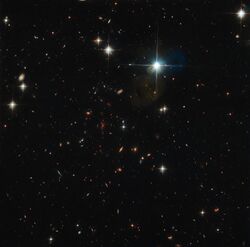Astronomy:SPT0615-JD
| SPT0615-JD | |
|---|---|
 SPT0615-JD (closer detailed image) using the NASA/ESA Hubble Space Telescope (the galaxy is located towards the upper left, to the right of the group of two stars and one galaxy) | |
| Observation data (J2000 epoch) | |
| Constellation | Pictor[1] |
| Right ascension | 06h 15m 55.03s[2] |
| Declination | −57° 46′ 19.56″[2] |
| Redshift | 9.9 [3] |
| Distance | 13.27 billion light-years (light travel time) [3] 31.4 billion light-years (comoving distance) |
| Characteristics | |
| Mass | ~3 ×109[2] M☉ |
| Size | < 2,500 ly[2] |
| Apparent size (V) | 0.00065 x 0.00065 |
| Other designations | |
| RELICS SPT-CL J0615-5746 336, SCB2018 SPTJ0615-JD1 | |
SPT0615-JD is a dwarf galaxy situated within the constellation Pictor, and is the farthest galaxy ever imaged by means of gravitational lensing, as of 2018.[1][3] Brett Salmon of the Space Telescope Science Institute in Baltimore was the lead scientist of the study of the galaxy.[2]
The galaxy was identified in the Hubble Space Telescope Reionization Lensing Cluster Survey (RELICS) and companion S-RELICS Spitzer program and is at the limits of Hubble's detection capabilities.[2] As a consequence of the effect of a gravitational field of a galaxy cluster of an extremely large size,[2] SPT-CL J0615-5746, (abbreviated to SPT0615),[1] situated at a distance closer to Earth, light from SPT0615-JD located at a further distance, is amplified and distorted (lensed - Einstein 1936; Khvolson 1924; Link 1936) on its motion to the Hubble telescope. This distortion causes the light from the galaxy to arrive as an image lengthened to an arc of about 2 arcseconds long.[2]
"JD" is short for "J-band Dropout" (the galaxy is not detected in the so-called J-band (F125W)[4] The observed image is of 13.3 billion years ago, indicating the galaxy existed when the universe was about only 500 million years in existence.[2] The galaxy is less than 2,500 light-years across.[2]
References
- ↑ 1.0 1.1 1.2 I. Karachentsev et al., F. High et al. - Distant and ancient Hubble Space Telescope Retrieved 2019-06-10
- ↑ 2.0 2.1 2.2 2.3 2.4 2.5 2.6 2.7 2.8 2.9 (January 11, 2018) NASA's Great Observatories Team Up to Find Magnified and Stretched Image of Distant Galaxy Jet Propulsion Laboratory, Pasadena, California, Retrieved 2019-06-10
- ↑ 3.0 3.1 3.2 Salmon, Brett; Coe, Dan; Bradley, Larry; Bradač, Marusa; Huang, Kuang-Han; Strait, Victoria; Oesch, Pascal; Paterno-Mahler, Rachel et al. (2018). "A Candidate z∼10 Galaxy Strongly Lensed into a Spatially Resolved Arc". The Astrophysical Journal 864: L22. doi:10.3847/2041-8213/aadc10.
- ↑ Daniel Coe with CLASH (PI Marc Postman) - Hubble Spies Most Distant Galaxy Yet Retrieved 2019-06-10
Additional reading
- Tilman Sauer (2008). "Nova Geminorum 1912 and the Origin of the Idea of Gravitational Lensing". Archive for History of Exact Sciences 62 (1): 1–22. doi:10.1007/s00407-007-0008-4. Bibcode: 2008AHES...62....1S.
- Turner, Christina (February 14, 2006). "The Early History of Gravitational Lensing". http://www.nd.edu/~hps/turner.pdf.
- Bičák, Jiří; Ledvinka, Tomáš (2014). General Relativity, Cosmology and Astrophysics: Perspectives 100 years after Einstein's stay in Prague (illustrated ed.). Springer. pp. 49–50. ISBN 9783319063492. https://books.google.com/books?id=Ax0qBAAAQBAJ&pg=PA49.
 |

